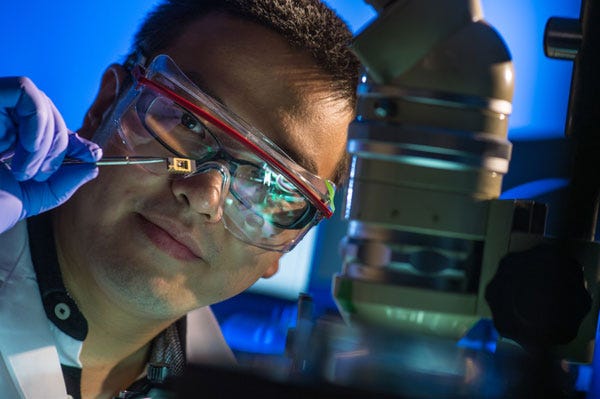A Remarkably Thin Material for Medical Imaging
December 22, 2014
A material that is hailed as the "thinnest-ever imaging platform" by Rice University (Houston, TX) could be integrated with electronics to create tiny imaging devices to monitor medical conditions in real-time.
The platform is based on an atomically thin layer of copper indium selenide (CIS) that is extremely sensitive to light--the new material is thought to be 10 times more efficient than the best alternative material currently available. The material also has the benefit of having a broad spectral response range. Synthesized in this research by Sidong Lei, a Rice graduate student, the 2-D material is comprised of a single-layer matrix of copper, indium, and selenium atoms.
To prove the material's ability to capture images, Lei integrated it into a three-pixel charge-coupled device (CCD). The small size of the device opens up an array of biological imaging applications, Lei says. "In the past, if you wanted to take an image of biological tissues, you would have to use a microscope or another complex imaging system with lenses that tended to be very bulky," he explains. "With the CIS device, you can just put the sensor on top of whatever you want to take an image of. You can just get rid of the bulky systems that were used in the past," Lei says.
|
Rice grad student Sidong Lei holds a 2-D material made from copper indium selenide that could be used for imaging devices that are one atom thick. Image from Jeff Fitlow/Rice University. |
Traditional silicon-based CCDs are thick and rigid, making it difficult to integrate with an atomically thick material. But the CIS-based CCD has the advantage of not only being superthin but also transparent and flexible.
The flexibility of CIS enables devices to be developed in which a user can adjust the curvature of the material to conform to the focal surface of the optical system, thus correcting for optical aberration. "If you have a good system, maybe you can even do that actively in real time," says Robert Vajtai, a senior faculty fellow at Rice and a colleague of Lei's.
The device works by trapping electrons that are formed when light hits the material and holds them until they are released for storage. CIS pixels are so sensitive to light because the trapped electrons dissipate extremely slowly.
Another benefit to Lei's material is that it is transparent, allowing for a CIS-based scanner to use light from one side to illuminate an image on the other side for capture.
The research on the 2-D materials used in this technology is an outgrowth of the discovery of graphene in 2004. Following that breakthrough, a wave of additional 2-D materials have been developed, paving the way for an array of electronic breakthroughs such as atomically layered field effect transistors and photodetectors.
The research on materials like CIS is noteworthy in that its is comprised of three elements; most research on 2-D materials in the past decade has been focused on materials comprised of one or two elements. Multielemental materials like CIS offer scientists more freedom for fine tuning their physical properties, owing to stoichiometric variation.
In addition, the Rice researchers report that, until recently, the use of 2-D materials in an optoelectronic memory for image sensing had not been demonstrated.
The researchers were hesitant to estimate how long it might be before such technology could be commercialized.
Refresh your medical device industry knowledge at MD&M West, in Anaheim, CA, February 10-12, 2015. |
Kristopher Sturgis is a contributor to Qmed and MPMN.
Like what you're reading? Subscribe to our daily e-newsletter.
About the Author(s)
You May Also Like



